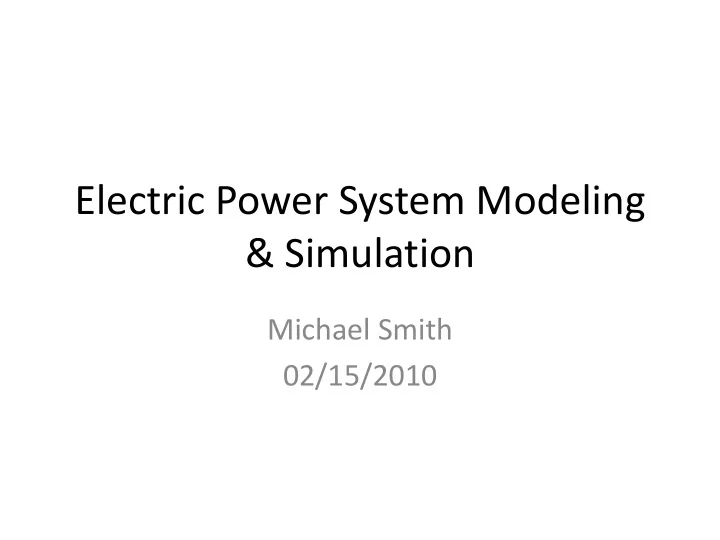

Electric Power System Modeling & Simulation Michael Smith 02/15/2010
Outline • Introduction • Power System Introduction/Background • Data Requirements • Model/Simulation Development • Analysis • Conclusion
Introduction Objective: • Understand the behavior of Electric Power (EP) systems Properties of EP systems: • Large scale, complicated, dynamic and nonlinear • Composed of interdependent, heterogeneous components • Result from incremental evolution in system North American Power System Outages (NERC Data 1984-2002) 0 10 configuration driven by response to failures and adoption of innovation -1 10 Frequency of outage • Possess considerable system structure (e.g., power law statistics, HDS configuration) -2 10 1996 Western Outage 1977 NY Outage 1965 NE Outage 2003 NE Outage -3 10 0 1 2 3 4 5 6 7 8 10 10 10 10 10 10 10 10 10 Number of customers affected by outage
Introduction/Motivation
The Cost of “Unreliability” August 14th Blackout 1 • Since 9/11, [reported] attacks 2 Canadian Provinces on industrial process control 8 U.S. states systems have increased 10 fold • 10 second electric power outage 3 deaths at LAX 12 airports closed – Tower-to-tower communication 23 cases of looting in Ottawa lost for three hours 100 power plants – Approximately 80 – 100 flights 9,266 square miles delayed 61,800 MW of power lost • Ohio nuclear power plant 1.5 million Cleveland residents disrupted by SQL Slammer worm without water • Stock market crashes 50 million people $4-6 billion in economic activity lost 1. US DOE, Office of Electric Transmission and Distribution, December 1, 2003, Bill Parks
Power System Background Pictorial View
Power Systems Background Model view V 0 0 V jX 2 jX 1 generation station transmission lines substation load • Components • Generation Station, Transmission network, Substation, Loads • Key Terms • Voltage, Power, Load flow, Steady State, Transient, Dynamic
Data Required for Modeling Data for Load-Flow/Power-Flow Model The first type of data requested is that needed to develop a load-flow/power-flow model of a power system area: – topology of the area with connection points (busses) as nodes and transmission lines and transformers as edges, – transmission line parameters such as pi-model parameters, compensation and ratings/limits, – transformer parameters such as pi-model, turns ratio and ratings/limits, – tie-line locations and ratings, – generation location and ratings/limits, – load locations and load compensation, and – any complete load-flow/power-flow solutions for area (from model or instrumentation) with data mentioned above, generator powers, load powers, line powers, and bus voltages and phase angles. Data for Dynamic Model In order to perform transient analysis and stability studies additional power system data is required to supplement that identified above for load-flow/power-flow models. Example data that would assist with construction of a dynamic model include: – number, size and type of generators with any available mechanical, electrical, and control (governor, voltage regulation, etc.) parameters, – mix of residential, commercial and industrial load at each bus, – location and specifications for distributed control devices such as tap-changing transformers, switched shunt compensation, static Var compensators, flexible AC transmission systems, etc., – location and specifications for protection devices such as relays and load shedding, and – location and specifications of any other relevant control and/or protection devices. Data for Model Validation Time-series data (generator powers, load powers, line powers, voltages, voltage phase angles, frequency, currents, etc.) recorded from the power system in response to short-term load fluctuation, 24-hour load variation or known disturbance is requested to support model validation studies and dynamic grid analysis. Data captured over the short term would be sampled at sub-second or faster while long-term would be sampled on intervals of 15 minutes.
Sinusoidal Steady-State Analysis
Detailed Model View • Equivalent π transmission line models • Single phase assuming 3 phases are symmetrical • p.u. (per unit system) ease of power system analysis
Complex Current Injections & Network Line Powers
Real/Imaginary Network & Power Balance Equations
Simplified Generator/Load Equations • Internal generator dynamics • Fixed load model – Power (fixed) – Internal dynamics (none)
Model Hybrid Dynamical System (HDS) discrete system: set points switching and saturation q 0 q 1 q 2 mode q i+1 = h(q i , k(x,y), r) grid changes outputs continuous system: generators, loads and network G L G disturbances L dx/dt = f q (x, y, u) 0 = g q (x, y)
Model Key features: • physics-based models of network, generators (electromechanical), and loads (aggregate) • emphasis placed upon – capturing saturation and switching behavior – drawing conclusions about system behavior (time evolution governed by dynamics) with limited data and uncertainty – keeping an eye towards analysis • Both dynamic and steady-state representations for the model
Model: dynamic vs. static model Static (load flow) Model HDS Model 0 = f(x, y, u) q i+1 = h(q i , k(x,y), r) dx/dt = f q (x, y, u) 0 = g(x, y) 0 = g q (x, y) (switching is exogenous) Area C Load Busses Area C Load Busses 1.05 16 16 49 49 50 1 50 51 51 52 52 53 53 54 54 71 0.8 71 72 72 1 75 75 68 68 73 73 87 87 0.6 67 67 88 88 89 89 76 76 78 78 79 0.4 0.95 79 80 80 81 81 84 84 85 85 0.2 0.9 0 0 50 100 150 200 250 300 350 400 450 500 0 50 100 150 200 250 300 350 400 450 500 static trajectory (equilibrium) solutions
Questions
Recommend
More recommend